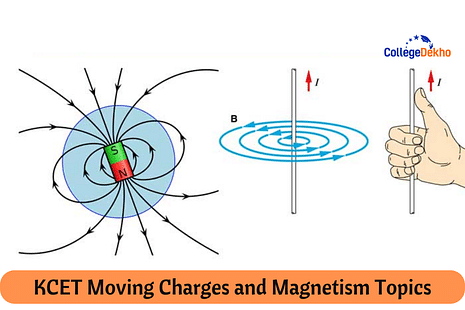
KCET Moving Charges and Magnetism Topics 2025 include Magnetic Force, Motion in a Magnetic Field, The Solenoid, Torque on the Current Loop, and Magnetic Dipole. This chapter is entirely based on how the magnetic field associates with charged particles (moving) such as protons, electrons, and current-carrying wires. KCET Moving Charges and Magnetism Weighatge 2025 is expected to be 2 to 3 questions carrying approximately 6 to 9 marks in the KCET 2025 Question Paper. The KCET Moving Charges and Magnetism Questions are asked in the form of MCQs. For every correct answer, candidates will be awarded 1 mark and there is no provision for negative marking for wrong answers. In this article, we have discussed the KCET 2025 Moving Charges and Magnetism Topics, sample questions, weightage, etc.
What is Moving Charges and Magnetism in KCET 2025?
The alignment of a needle in a compass led to an interesting discovery about how electricity and magnetism are related. Researchers found that the needle points in a certain direction, which can be imagined as a tangent to an invisible circle around a straight wire placed in the centre. Normally, the needle stays in this position, but when electricity flows through the wire, the needle moves to a different angle. This movement happens because the electric current creates a magnetic field. The way the needle deflects is explained by a simple rule known as Ampere’s swimming rule, which helps us understand the direction of this magnetic influence.
KCET Moving Charges and Magnetism Topics 2025
Here are the topics covered in KCET 2025 Moving Charges and Magnetism.
- Introduction to Moving Charges and Magnetism
- Magnetic Force
- Motion in a Magnetic Field
- Magnetic Field due to a Current Element, Biot-Savart Law
- Magnetic Field on the Axis of a Circular Current Loop
- Ampere’s Circuital Law
- The Solenoid
- Force between Two Parallel Currents, the Ampere
- Torque on Current Loop, Magnetic Dipole
- The Moving Coil Galvanometer
1. Ampere’s Swimming Rule
According to the rule, imagine a swimmer swimming along a wire in the direction of the electric current, facing the compass needle. The needle’s north pole would be deflected to the left.
2. Magnetic Field
A stationary charge creates an electric field, while a moving charge generates a magnetic field, represented by the letter B. The shape of this field changes depending on the shape of the conductor carrying the current.
3. Motion of Charged Particles in a Magnetic Field
When a charged particle (like an electron) moves in a magnetic field, it experiences a force described by the equation:
\[F = qvB \sin θ\]
Here, F is the force, q is the charge, v is the speed, B is the magnetic field, and θ is the angle between the speed and the magnetic field. Since this magnetic force is always perpendicular to the motion, it doesn’t affect the particle's speed or energy.
- Case 1 If the angle θ is 0° or 180° (the particle moves parallel to the magnetic field), it will keep moving in a straight line. Case 1: θ = 00 0r 1800
- Case 2 If θ is 90° (the particle moves perpendicular to the magnetic field), it will move in a circular path. The magnetic force acts as a centripetal force, keeping the particle in that circle. Case 2: θ = 900
4. Biot-Savart Law
Biot-Savart Law helps us understand how a small segment of a current-carrying wire creates a magnetic field at a point nearby. The magnetic field produced depends on the current, the length of the wire segment, and how far away you are from it.
5. Ampere’s Circuital Law
Ampere’s Circuital Law states that the total magnetic field around a closed loop is proportional to the total current flowing through that loop. You can think of it as a way to calculate the magnetic field created by currents in various configurations.
6. Magnetic Field from a Straight Current-Carrying Wire
When you have a long, straight wire carrying current, you can use Ampere's Law to find the magnetic field around it:
\[B = \frac{μ_0 I}{2 \pi r}\]
7. Magnetic Field Due to a Solenoid
A solenoid is a long coil of wire. When electric current passes through it, it produces a strong and uniform magnetic field inside.
Quick Links:
KCET 2025 Moving Charges and Magnetism Questions
1. (a) A circular coil of 30 turns and radius 8.0 cm carrying a current of 6.0 A is suspended vertically in a uniform horizontal magnetic field of magnitude 1.0 T. The field lines make an angle of 60° with the normal of the coil. Calculate the magnitude of the counter torque that must be applied to prevent the coil from turning.
(b) Would your answer change, if the circular coil in (a) were replaced by a planar coil of some irregular shape that encloses the same area? (All other particulars are also unaltered.)
Ans.4.13
2. Two concentric circular coils X and Y of radii 16 cm and 10 cm, respectively, lie in the same vertical plane containing the north-to-south direction. Coil X has 20 turns and carries a current of 16 A; coil Y has 25 turns and carries a current of 18 A. The sense of the current in X is anticlockwise, and clockwise in Y, for an observer looking at the coils facing west. Give the magnitude and direction of the net magnetic field due to the coils at their centre.
Ans.4.14
3. A magnetic field of 100 G (1 G = 10–4 T) is required which is uniform in a region of linear dimension about 10 cm and area of cross-section about 10–3 m2. The maximum current-carrying capacity of a given coil of wire is 15 A and the number of turns per unit length that can be wound round a core is at most 1000 turns m–1. Suggest some appropriate design particulars of a solenoid for the required purpose. Assume the core is not ferromagnetic.
Ans.4.15
4. A toroid has a core (non-ferromagnetic) of inner radius 25 cm and outer radius 26 cm, around which 3500 turns of a wire are wound. If the current in the wire is 11 A, what is the magnetic field (a) outside the toroid, (b) inside the core of the toroid, and (c) in the space surrounded by the toroid?
Ans.4.17
5. Answer the following questions:
(a) A magnetic field that varies in magnitude from point to point but has a constant direction (east to west) is set up in a chamber. A charged particle enters the chamber and travels undeflected along a straight path with constant speed. What can you say about the initial velocity of the particle?
(b) A charged particle enters an environment of a strong and non-uniform magnetic field varying from point to point both in magnitude and direction and comes out of it following a complicated trajectory. Would its final speed equal the initial speed if it suffered no collisions with the environment?
(c) An electron travelling west to east enters a chamber having a uniform electrostatic field in north to south direction. Specify the direction in which a uniform magnetic field should be set up to prevent the electron from deflecting from its straight-line path.
Ans.4.18
6. A magnetic field set up using Helmholtz coils (described in Exercise 4.16) is uniform in a small region and has a magnitude of 0.75 T. In the same region, a uniform electrostatic field is maintained in a direction normal to the common axis of the coils. A narrow beam of (single species) charged particles all accelerated through 15 kV enters this region in a direction perpendicular to both the axis of the coils and the electrostatic field. If the beam remains undeflected when the electrostatic field is 9.0 × 10–5 V m–1, make a simple guess as to what the beam contains. Why is the answer not unique?
Ans.4.20
Related Articles:
Are you feeling lost and unsure about what career path to take after completing 12th standard?
Say goodbye to confusion and hello to a bright future!

FAQs
The cutoff of KCET refers to the minimum marks required by candidates to qualify for the KCET exam. KEA KCET cutoff is released separately for the general merit and Hyderabad Karnataka region. The exam authority releases the KCET cutoff after each counselling round.
It is not mandatory to attempt the Biology paper in the KCET exam if you want to opt for Engineering. Biology marks are only considered for the Medical, Dental and Paramedical fields. However, if you want to pursue Biotechnology in Engineering, attempting Biology in the KCET exam is compulsory.
50% mark is the passing percentage for the general category candidates and 40% for the SC/ST/OBC category for the KCET exam.
As per the previous year exam analysis, the KCET 2025 exam might be of a moderate to difficult level. KCET questions will be based on the first and second-year PUC syllabus as determined by the Department of Pre-University Education of Karnataka State.
Candidates cannot skip Mathematics in the KCET exam. Mathematics is a mandatory subject in the KCET exam, and skipping it would disqualify candidates from the KCET examination.
Candidates looking to score good marks in the Karnataka CET exam are advised to solve the KCET previous year question papers and mock tests. Solving PYQs of KCET will enable candidates to get an idea about the KCET question paper pattern and the marking scheme.
NCERT best books are a good choice for candidates to start if they want to prepare for the KCET 2025 exam. Upon finishing the NCERT books, candidates can move ahead to the crucial KCET best books. Additionally, the KCET best books are another resource that candidates can use to study for the KCET exam.
The identical chapters and subjects from Classes 11 and 12 are covered by the questions in both KCET and JEE Main exams. However, in comparison to KCET, the questions in the JEE Main exam are more difficult.
In KCET Physics, chapters such as Gravitation, Motion in a Straight Line, Oscillations, and Thermodynamics each contribute approximately 7% to 8% of the exam paper.
Chapters with maximum weightage in KCET Physics are Gravitation, Motion in a Straight Line, Oscillations and Thermodynamics since they carry 7% to 8% weightage. Important chapters for KCET Maths comprise Integration, Vectors, Permutation and Combination, and 3-D Geometry which weigh around 6% to 7% in the KCET exam.
KCET Moving Charges and Magnetism chapter is entirely based on how the magnetic field associates with charged particles (moving) such as protons, electrons, and current-carrying wires.
KCET Moving Charges and Magnetism Weighatge 2025 is expected to be 2 to 3 questions carrying approximately 6 to 9 marks in KCET 2025 Question Paper.
KCET Moving Charges and Magnetism Topics 2025 include Magnetic Force, Motion in a Magnetic Field, The Solenoid, Torque on the Current Loop, and Magnetic Dipole.
Was this article helpful?




















Similar Articles
List of Documents Required for TS ECET Counselling 2025
DTE MP BE/ B.Tech Admission 2025 - Dates (Out), Eligibility, Merit List, Counselling Process
JEECUP 2025 Seat Matrix - List of Colleges, Courses & Fee
JEE Advanced IIT Kharagpur Civil Engineering Cutoff 2025
List of Colleges for 50,000 to 75,000 Rank in JEECUP 2025
JEE Advanced IIT Dhanbad Civil Engineering Cutoff 2025